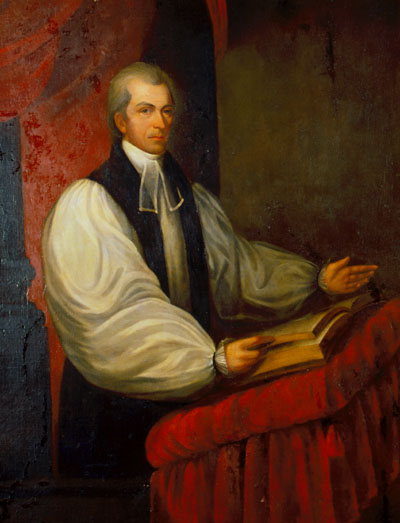Difference between revisions of "James Madison, Bishop"
| Line 44: | Line 44: | ||
|knownfor= | |knownfor= | ||
|signature= | |signature= | ||
| − | }} | + | }}James Madison (1749 – 1812) was president of the [http://www.wm.edu/ College of William & Mary] from 1777 to 1812, first bishop of the Protestant Episcopal Church in Virginia, and a cousin of [[wikipedia:James Madison|James Madison, Jr.]], later the fourth President of the United States. |
| − | + | Bishop Madison attended the College of William & Mary, graduating with high honors in 1771. After studying with [[George Wythe]], he was admitted to the bar but never chose to pursue a legal career. Instead, in 1773, he was elected professor of natural philosophy and mathematics at the college. After a brief stint in England to further his studies and seek ordination to the ministry of the Church of England, he returned to Williamsburg and his position as a professor at the college. In 1777, the Board of Visitors elected him president of the college, a position he would hold until his death. In 1779, he worked with [[Thomas Jefferson]] (then Governor of Virginia and a member of the college's Board of Visitors), to create the position of [[Professor of Law and Police]] at William & Mary. | |
| − | + | Following the Revolution, Madison played an instrumental role in the reorganization of the Episcopal Church in Virginia and was elected bishop in 1790. Madison died on March 6, 1812 and was buried in the chapel at the College of William & Mary. | |
| − | |||
[[Category:Wythe's Students]] | [[Category:Wythe's Students]] | ||
Revision as of 16:55, 12 February 2016
| The Right Reverend Dr. | |
| James Madison | |
| Bishop, Episcopal Diocese of Virginia | |
| In office | |
| 1790 – 1812 | |
| Preceded by | Inaugural holder |
| President, College of William & Mary | |
| In office | |
| 1777 – 1812 | |
| Preceded by | John Camm |
| Succeeded by | John Bracken |
| Personal details | |
| Born | August 27, 1749 |
| Died | March 6, 1812 |
| Relatives | John Madison (father) Agatha Strother (mother) James Madison, Jr. (cousin) |
James Madison (1749 – 1812) was president of the College of William & Mary from 1777 to 1812, first bishop of the Protestant Episcopal Church in Virginia, and a cousin of James Madison, Jr., later the fourth President of the United States.
Bishop Madison attended the College of William & Mary, graduating with high honors in 1771. After studying with George Wythe, he was admitted to the bar but never chose to pursue a legal career. Instead, in 1773, he was elected professor of natural philosophy and mathematics at the college. After a brief stint in England to further his studies and seek ordination to the ministry of the Church of England, he returned to Williamsburg and his position as a professor at the college. In 1777, the Board of Visitors elected him president of the college, a position he would hold until his death. In 1779, he worked with Thomas Jefferson (then Governor of Virginia and a member of the college's Board of Visitors), to create the position of Professor of Law and Police at William & Mary.
Following the Revolution, Madison played an instrumental role in the reorganization of the Episcopal Church in Virginia and was elected bishop in 1790. Madison died on March 6, 1812 and was buried in the chapel at the College of William & Mary.
